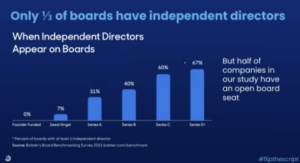Building and Compensating Your Board
For frequent readers of this blog, you know I’ve written a lot about startup boards including the importance of diversity and being deliberate about how many investors you have on your board (hint: likely too many).
Last month I joined Bolster and compensation consulting firm J.Thelander for a conversation on building and compensating boards in the most effective way possible. This is an important topic, and I wanted to share and emphasize a few insights from the conversation. If you’re interested in watching the full session you can do that here. Much of the data shared by Bolster can also be found in their Board Benchmark report that I wrote about earlier this year.
The role of the independent director is an important (and often under-utilized) strategy for CEOs.
- One surprising thing that Bolster found in their board benchmarking study is that only 1 in 3 private boards today have independent directors. That’s not uncommon for the earliest boards, but it surprised me that overall the rate was this high. It’s a missed opportunity for companies to gain valuable insight, perspective, and network extension.
Investors can (and sometimes should) make room for independent board directors.
- Historically, when an investor board member steps off of a board, it has been seen as a negative signal. This is backward thinking and something our industry should aim to fix. Investors shouldn’t have a board seat for life and it’s often very healthy for a company to have some turn-over at the board level (especially among investors) as it grows. More and more at Foundry, we’re stepping off of boards of great companies that we feel have enough other investor board members with huge platforms behind them. Other firms are starting to do the same.
Independent directors are a leading source of diversity on boards.
- Conversations have materially shifted from just talking about diversity to actually doing something about it in the past 12-18 months.
- This includes being open to first-time board members. It’s worth saying that some of the best board members I’ve worked with were first-time board members. There is a bias against taking on first-time board members that is irrational.
- Anecdotally, we talked about CROs and CHROs becoming more sought after for board roles, many of those executives may not have formal board experience but could bring immense value to the table.
Unsurprisingly, private company directors are almost exclusively being compensated with equity so the details of those equity grants are important.
- While option grants have historically been at about a 4-year vesting schedule, the data showed more and more companies favoring 2 or 3 year schedules.
- I think this is a healthy shift and forcing function for conversations about keeping the board fresh (see the points above).
- A majority of these independent directors have accelerated vesting (as they should, in my view). According to J. Thelander’s data (n=123), ~70% of outside members of the board have 100% acceleration of their options. Also, 80% had “single trigger” acceleration so that change of control alone is enough to trigger the acceleration.
Grants vary by stage – or rather total amount raised as stages are becoming less relevant when there are these mega Seed/Series A rounds.
- Generally speaking, an independent board member should get a grant approximately equal to something between a director and a VP level.
- At 3-4 years, you should have a conversation if it makes sense to re-up for another period or not (again, keeping in mind that some turn-over at the board level is actually positive for a business).
Board meeting tactics matter.
- Gone are the days of board meetings every month (for most companies).
- Some of the best board meetings I’m part of share these common traits:
- Material is circulated a few days in advance – and in a consistent format over time – and it’s expected everyone has reviewed it
- Meetings run 3-4 hours with a few planned breaks
- Exec team members are included in part of all of the meetings
- The CEO is clear about discussion vs. decision items
- Varying opinions are welcome
- They cover why, not just what
- Every meeting should have an executive session
- Follow-up items are noted
I wrote a series of posts here on how to manage your board and board meetings if you’re interested in digging deeper into that subject.
I hope the insights above help company leaders be more thoughtful about their board. Used properly they can be massively impactful to a company’s success.



